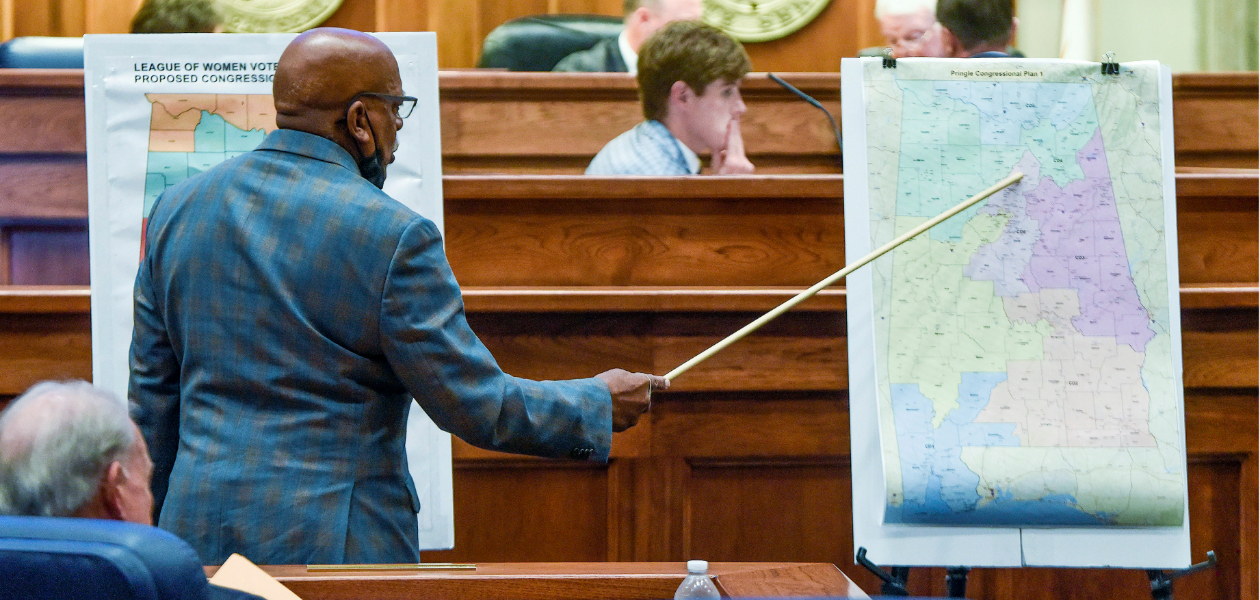
In an under-the-radar move to boost the GOP’s chances in November, the right-wing Supreme Court has told four states where lower courts found Republican legislators illegally drew congressional boundaries to exclude both Black and Democratic voters that they can go ahead and use those illegal maps in the November election.
The four states involved, Alabama, Georgia, Louisiana, and Ohio, together elect 10% of the members of the U.S. Congress. The illegal maps they are using will turn at least five but as many as seven seats from guaranteed Democratic districts, or districts with Black majorities, over to Republicans instead. In a Congress where Democrats are hanging onto a razor-thin majority, this could, in a close election, hand control over that body to the Republicans, rewarding their state legislators for drawing racist and exclusionary lines.
The racist advantage being handed to Republicans in the 2022 congressional elections results from a shift in thinking on the Supreme Court, led by judges appointed by Donald Trump but including other right-wingers on the Court.

In the past, when state courts declared maps to be illegal, they either re-drew the maps themselves or ordered them to be re-drawn by the state legislatures or by special independent commissions. This time, the Supreme Court has said the four sets of illegal maps must remain in place in those states, using the rationale that it is too close to the coming election to make changes. The overriding principle involved, their argument goes, is that you can’t change election rules midstream. They made no such argument when the GOP legislative bodies in those states threw out their old maps and replaced them with racist and gerrymandered maps.
Election experts say that, as a result, Republicans will almost certainly gain five to seven seats that they do not now have. Those figures come from David Wasserman, who writes the sections of the Cook Political Report that deal with congressional redistricting.
To cement the illegal districts in place for this election the right-wingers on the Court have concocted their own doctrine that changes in election procedures cannot be ordered too close to an election. How far out from Election Day is considered “too close” is left undetermined, however. The argument, which ignores the consequences of racist gerrymanders, tosses out justice in favor of the need to avoid alleged “voter confusion,” supposedly providing an “incentive to stay away from voting.”
It is not at all surprising, of course, that Republican-appointed justices see “confusion” as more harmful to democracy than racist gerrymandering.
What they are saying is that a rigged but smoothly-run election is more important than a just and fair free election. Under that logic, the smoothest and best elections would be ones that banned any and all opposition parties. There would be nothing to challenge or squabble about then.
In Alabama, in January, the state court said the Republican legislature had drawn up district lines that violated the Voting Rights Act by diluting Black voters’ power in its new maps. That was four months before the primary election in the state, and that court ordered the Legislature to draw up new maps.

Two weeks later, acting for the Supreme Court, Justice Brett Kavanaugh issued a stay blocking that court order for new maps. “When an election is close at hand, the rules of the road must be clear and settled,” he said.
Dissenting was Justice Elena Kagan, who said, “Alabama is not entitled to keep violating Black Alabamans’ voting rights just because the court’s order came down in the first month of an election year.”
Only a month later, a federal judge in Georgia cited the Kavanaugh logic as the reason not to order new maps in that state that had been declared illegal by that state’s court. Under the Kavanaugh logic, all a Republican Legislature has to do when it dilutes Black voting rights is to delay its action until it gets closer to the election when the Supreme Court will then say it is too close to make any changes. This is what happened in all the four states operating now in this election with maps that their own courts had declared in violation of the Voting Rights Act.
Draw racist district lines and then slow-walk everything to win a victory for the forces killing Black voting rights—that’s the lesson right-wing Republicans have learned from the dangerous and reactionary Supreme Court that acts now as a clamp slowly squeezing the life out of our democracy.
The solution is to double down on the massive effort to kick Republicans out of office this November, up and down the line. They must be removed from both the halls of Congress and the legislative bodies in the states. The future of democracy is hanging in the balance.










